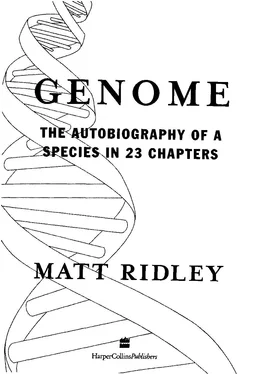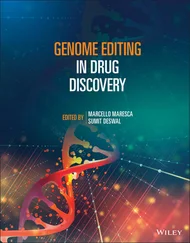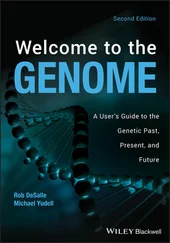Genome - Matt Ridley
Здесь есть возможность читать онлайн «Genome - Matt Ridley» — ознакомительный отрывок электронной книги совершенно бесплатно, а после прочтения отрывка купить полную версию. В некоторых случаях можно слушать аудио, скачать через торрент в формате fb2 и присутствует краткое содержание. Жанр: Старинная литература, на английском языке. Описание произведения, (предисловие) а так же отзывы посетителей доступны на портале библиотеки ЛибКат.
- Название:Matt Ridley
- Автор:
- Жанр:
- Год:неизвестен
- ISBN:нет данных
- Рейтинг книги:5 / 5. Голосов: 1
-
Избранное:Добавить в избранное
- Отзывы:
-
Ваша оценка:
- 100
- 1
- 2
- 3
- 4
- 5
Matt Ridley: краткое содержание, описание и аннотация
Предлагаем к чтению аннотацию, описание, краткое содержание или предисловие (зависит от того, что написал сам автор книги «Matt Ridley»). Если вы не нашли необходимую информацию о книге — напишите в комментариях, мы постараемся отыскать её.
Matt Ridley — читать онлайн ознакомительный отрывок
Ниже представлен текст книги, разбитый по страницам. Система сохранения места последней прочитанной страницы, позволяет с удобством читать онлайн бесплатно книгу «Matt Ridley», без необходимости каждый раз заново искать на чём Вы остановились. Поставьте закладку, и сможете в любой момент перейти на страницу, на которой закончили чтение.
Интервал:
Закладка:
The ethical and safety fears proved so far groundless: in thirty years of genetic engineering no environmental or public health accident big or small has resulted from a genetic engineering experiment. So far, so good.
Meanwhile, genetic engineering had a greater impact on science than it had on business. It was now possible to 'clone' genes (in 2 4 6 G E N O M E
this context the word has a different meaning from the popular one): to isolate a 'needle' of a human gene in the 'haystack' that is the genome, put it in a bacterium and grow millions of copies of it so that they can be purified and the sequence of letters in the gene read. By this means, vast libraries of human D N A have been created containing thousands of overlapping fragments of the human genome, each present in sufficient quantity to study.
It is from such libraries that the people behind the Human Genome Project are piecing together the complete text. The scale of their task is immense. Three billion letters of text would fill a stack of books 150 feet high. The Wellcome Trust's Sanger Centre near Cambridge, which leads the effort, is reading the genome at the rate of 100 million letters a year.
There are, of course, short cuts. One is to ignore the ninety-seven per cent of the text that is silent - the selfish D N A , the introns, repetitious minisatellites and rusting pseudogenes - and concentrate on the genes alone. The quickest way to find such genes is to clone a different sort of library, called a cDNA library. First, sieve out all fragments of R N A in the cell. Many of them will be messengers —
edited and abridged copies of genes in the process of being translated. Make D N A copies of those messengers and you will have, in theory, copies of the texts of the original genes with none of the junk D N A that lies in between. The main difficulty with this approach is that it gives no hint of the order or position of the genes on the chromosomes. By the late 1990s there was a marked difference of opinion between those who wanted to pursue this
'shotgun' method to the human genome with commercial patenting along the way, and those who wanted to be slow, thorough and public. On one side was a high-school drop-out, former professional surfer, Vietnam veteran and biotechnology millionaire named Craig Venter, backed by his own company Celera; on the other a studious, bearded, methodical Cambridge-educated scientist, John Sulston, backed by the medical charity Wellcome Trust. No prizes for guessing which camp is which.
But back to manipulation. Engineering a gene into a bacterium C U R E S 2 4 7
is one thing; inserting a gene into a human being is quite another.
Bacteria are happy to absorb little rings of D N A called plasmids and adopt them as their own. Moreover, each bacterium is a single cell. Human beings have 100 trillion cells. If your goal is to genetically manipulate a human being, you need to insert a gene into every relevant cell, or start with a single-celled embryo.
The discovery in 1970 that retroviruses could make D N A copies from R N A suddenly made 'gene therapy' seem, nonetheless, a feas-ible goal. A retrovirus contains a message written in R N A which reads, in essence: 'Make a copy of me and stitch it into your chromosome.' All a gene therapist need do is take a retrovirus, cut out a few of its genes (especially those that make it infectious after the first insertion), put in a human gene, and infect the patient with it.
The virus goes to work inserting the gene into the cells of the body and, lo, you have a genetically modified person.
Throughout the early 1980s, scientists worried about the safety of such a procedure. The retrovirus might work too well and infect not just the ordinary cells of the body, but the reproductive cells, too. The retrovirus might reacquire its missing genes somehow and turn virulent; or it might destabilise the body's own genes and trigger cancer. Anything might happen. Fears about gene therapy were inflamed in 1980 when Martin Cline, a scientist studying blood disorders, broke a promise not to try inserting a harmless recombinant gene into an Israeli suffering from the genetic blood disorder thalassaemia (though not by retrovirus). Cline lost his job and his reputation; the result of his experiment was never published. Everybody agreed that human experiments were premature, to say the least.
But mouse experiments were proving both reassuring and disappointing. Far from being unsafe, gene therapy seemed more likely to be unworkable. Each retrovirus can only infect one kind of tissue; it needs careful packaging to get the genes into its envelope; it lands at random anywhere among the chromosomes and often fails to get switched on; and the body's immune system, primed by the crack troops of infectious disease, does not miss a clumsy, home-made 248 G E N O M E
retrovirus. Moreover, by the early 1980s so few human genes had been cloned that there was no obvious candidate gene to put in a retrovirus even if it could be got to work.
None the less, by 1989 several milestones had been passed. Retroviruses had carried rabbit genes into monkey cells; they had put cloned human genes into human cells; and they had put cloned human genes into mice. Three bold, ambitious men - French Anderson, Michael Blaese and Steven Rosenberg - decided the time was ripe for a human experiment. In a long and sometimes bitter battle with the American federal government's Recombinant D N A Advisory Committee, they sought permission for an experiment on terminal cancer patients. The argument brought out the different priorities of scientists and doctors. To the pure scientists, the experiment seemed hasty and premature. To the doctors, used to watching patients die of cancer, haste comes naturally. 'What's the rush?'
asked Anderson at one session. 'A patient dies of cancer every minute in this country. Since we began this discussion 146 minutes ago, 146 patients have died of cancer.' Eventually, on 20 May 1989, the committee granted permission and two days later Maurice Kuntz, a truck driver dying from melanoma, received the first deliberately introduced (and approved) new gene. It was not designed to cure him, nor even to remain in his body permanently. It was simply an adjunct to a new form of cancer treatment. A special kind of white blood cell, good at infiltrating tumours and eating them, had been cultivated outside his body. Before injecting them back in, the doctors infected them with retroviruses carrying a little bacterial gene, the only purpose of which was to enable them to track the cells inside his body and find out where they went. Kuntz died, and nothing very surprising emerged from the experiment. But gene therapy had begun.
By 1990, Anderson and Blaese were back before the committee with a more ambitious scheme. This time the gene would actually be a cure, rather than just an identification tag. The target was an extremely rare inherited disease called severe combined immune deficiency ( S C I D ) , which rendered children incapable of mounting C U R E S 2 4 9
an immune defence against infection; the cause was the rapid death of all white blood cells. Unless kept in a sterile bubble or given a complete bone marrow transplant from a fortuitously matched relative, such a child faces a short life of repeated infection and illness.
The disease is caused by a 'spelling' change in a single gene on chromosome 20, called the ADA gene.
Anderson and Blaese proposed to take some white blood cells from the blood of a S C I D child, infect them with a retrovirus armed with a new ADA gene, and transfuse them back into the child's body. Once again, the proposal ran into trouble, but this time the opposition came from a different direction. By 1990, there was a treatment for S C I D , called P E G - A D A , and it consisted of ingeniously delivering into the blood not the ADA gene, but A D A itself, the protein made by the equivalent gene in cattle. Like the cure for diabetes (injected insulin) or for haemophilia (injected clotting agents), S C I D had been all but cured by protein therapy (injected P E G - A D A ) . What need was there of gene therapy?
Читать дальшеИнтервал:
Закладка:
Похожие книги на «Matt Ridley»
Представляем Вашему вниманию похожие книги на «Matt Ridley» списком для выбора. Мы отобрали схожую по названию и смыслу литературу в надежде предоставить читателям больше вариантов отыскать новые, интересные, ещё непрочитанные произведения.
Обсуждение, отзывы о книге «Matt Ridley» и просто собственные мнения читателей. Оставьте ваши комментарии, напишите, что Вы думаете о произведении, его смысле или главных героях. Укажите что конкретно понравилось, а что нет, и почему Вы так считаете.












